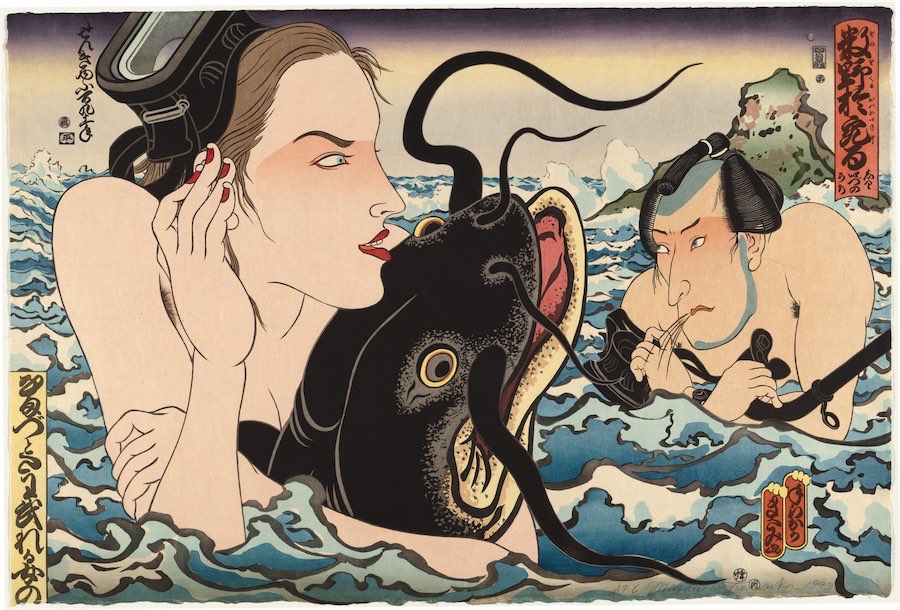The National Gallery has long nurtured an interest in the ukiyo-e (“Floating World”) woodblock prints of 17th-19th century Japan.
In 2001 a seminal NGA exhibition, Monet & Japan, took advantage of the fact that the great French impressionist Claude Monet had a huge collection of ukiyo-e prints in his Giverny home to trace influences of Eastern on Western art.
The gallery has collected a wide variety of traditional woodblock prints, including those by famous exponents, Katsushika Hokusai, Utagawa Kunisada, Utagawa Kuniyoshi, Toyohara Kunichika and Tsukioka Yoshitoshi.
Now there is a buzz of excitement at the NGA with the impending, long-awaited arrival of a modern-day ukiyo-e master, Japanese American artist Masami Teraoka, who will be in town in mid-February to see the first Australian exhibition dedicated to his work, Masami Teraoka and Japanese Ukiyo-E-Prints.
His contemporary works are displayed alongside those of traditional ukiyo-e artists.
It may not be immediately obvious to those unfamiliar with the traditional art but they, like those of Teraoka, dealt with their own world and not a nostalgic world from the past, so that we see inhabitants of Edo (now Tokyo) going about their business, visiting Kabuki theatres, and enjoying themselves in tea and bath houses.
Teraoka introduces modern Western figures into his scenes, with a predilection for pictures of bijin-ga, beautiful women, yūrei-zu, ghosts, demons and supernatural beings, and most famous, the shunga, graphically detailed erotic prints.
Teraoka has picked up on several of these themes to reflect on globalisation and the collision between Asian and Western cultures, using his mixture of Eastern and Western faces and bodies, some critics have said, to make comment on the male gaze.
In Catfish Envy, for instance, a Japanese Samurai leers at a Western woman who embraces a catfish, but what does it mean?
Teraoka is probably best-known here for his body of work commenting on the AIDS crisis, seen in the National Gallery’s 1994 exhibition Don’t Leave Me This Way: Art in the Age of AIDS, which just marked its 30th anniversary.

A highlight of the current show is the folding screen AIDS Series/Makiki Heights Disaster, 1988, which was acquired by the NGA in 2023.
Born in Japan in 1936, Teraoka moved in 1961 to Los Angeles, where he became an observer of Japanese and American culture, often in collision.
From the early 1970s, he took up the traditional visual vocabulary of the ukiyo-e woodblock prints to comment on the world around him, provocatively fusing cultural images, although her preferred his prints to be executed in Japan with artisans engaged for each component of the papermaking, carving and printing.
The exhibition is part of the National Gallery’s Kenneth E Tyler Collection exhibition series, and focuses on Teraoka’s Hawaii Snorkel Series, published by Tyler Graphics in 1992-93, looking at the hybrid techniques and innovative approaches Tyler employed to help Teraoka realise his vision.
Masami Teraoka and Japanese Ukiyo-E-Prints, National Gallery of Australia until July 6.
Who can be trusted?
In a world of spin and confusion, there’s never been a more important time to support independent journalism in Canberra.
If you trust our work online and want to enforce the power of independent voices, I invite you to make a small contribution.
Every dollar of support is invested back into our journalism to help keep citynews.com.au strong and free.
Thank you,
Ian Meikle, editor






